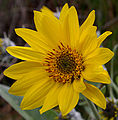Balsamorhiza sagittata
| Balsamorhiza sagittata | |
|---|---|

| |
| Balsamorhiza sagittata
(near Horselake, Chelan County, Washington) | |
| Scientific classification | |
| Kingdom: | Plantae |
| Clade: | Tracheophytes |
| Clade: | Angiosperms |
| Clade: | Eudicots |
| Clade: | Asterids |
| Order: | Asterales |
| Family: | Asteraceae |
| Genus: | Balsamorhiza |
| Species: | B. sagittata
|
| Binomial name | |
| Balsamorhiza sagittata | |

| |
| Distribution in North America | |
| Synonyms[1] | |
| |
Balsamorhiza sagittata is a North American species of flowering plant in the tribe Heliantheae of the family Asteraceae known by the common name arrowleaf balsamroot. Also sometimes called Oregon sunflower,[2][3] it is widespread across western Canada and much of the western United States.[4]
Description

This is a
The
B. deltoidea is similar but is greener, less hairy, and does not retain its ray flowers for long.[5]
Distribution and habitat
The plant's native range extends from
Ecology
The species hybridizes with Balsamorhiza hookeri.[10]
Grazing animals find the plant palatable, especially the flowers and developing seed heads.[11] Elk and deer browse the leaves.[15]
Uses
Coming into season in late spring, all of the plant can be eaten—particularly the leaves (raw or cooked), roots (cooked), and the seeds, raw or pounded into flour.[14][16] It can be bitter and pine-like in taste.[17] The leaves are best collected when young and can carry a citrus flavor.[18]
Many Native American groups, including the
Culture
A specimen was collected by explorer and
Under the name Okanagan Sunflower, it is the official flower emblem of the city of Kelowna, British Columbia, Canada.[22]
Gallery
-
Balsamorhiza sagittata flower head
-
Balsamorhiza sagittata insect predation
-
Balsamorhiza sagittata involucre.
-
Balsamorhiza sagittata
-
Balsamorhiza sagittata in Grand Teton National Park, Wyoming, US
-
Balsamorhiza sagittata in East Knox Mountain Park, British Columbia, Canada.
-
Balsamorhiza sagittata seedling
-
Balsamorhiza sagittata leaves sprouting from mature plant in early spring
-
Balsamorhiza sagittata mature seed heads in June
-
Balsamorhiza sagittata mature seed head
-
Balsamorhiza sagittata seeds
-
Balsamorhiza sagittata dry plants in fall that are dormant
-
Bright orange-yellow petals are a distinguishing characteristic of Balsamorhiza sagittata
References
- ^ "Balsamorhiza sagittata (Pursh) Nutt.". The Global Compositae Checklist (GCC) – via The Plant List. Note that this website has been superseded by World Flora Online
- ^ "Herb: Oregon Sunflower".
- ^ "Balsamorhiza sagittata - (Pursh.)Nutt".
- ^ a b "Balsamorhiza sagittata". County-level distribution map from the North American Plant Atlas (NAPA). Biota of North America Program (BONAP). 2014.
- ^ ISBN 978-0-375-40233-3.
- ^ Klinkenberg, Brian, ed. (2014). "Balsamorhiza sagittata". E-Flora BC: Electronic Atlas of the Plants of British Columbia [eflora.bc.ca]. Lab for Advanced Spatial Analysis, Department of Geography, University of British Columbia, Vancouver. Retrieved 2015-02-07.
- ^ Giblin, David, ed. (2015). "Balsamorhiza sagittata". WTU Herbarium Image Collection. Burke Museum, University of Washington. Retrieved 2015-02-07.
- ^ Keil, David J. (2012). "Balsamorhiza sagittata". In Jepson Flora Project (ed.). Jepson eFlora. The Jepson Herbarium, University of California, Berkeley. Retrieved 2015-02-07.
- ^ Weber, William A. (2006). "Balsamorhiza sagittata". In Flora of North America Editorial Committee (ed.). Flora of North America North of Mexico (FNA). Vol. 21. New York and Oxford: Oxford University Press – via eFloras.org, Missouri Botanical Garden, St. Louis, MO & Harvard University Herbaria, Cambridge, MA.
- ^ OCLC 25708726.
- ^ a b c McWilliams, Jack (2002). "Balsamorhiza sagittata". Fire Effects Information System (FEIS). US Department of Agriculture (USDA), Forest Service (USFS), Rocky Mountain Research Station, Fire Sciences Laboratory.
- ^ Sullivan, Steven. K. (2015). "Balsamorhiza sagittata". Wildflower Search. Retrieved 2015-02-07.
- ^ USDA, NRCS (n.d.). "Balsamorhiza sagittata". The PLANTS Database (plants.usda.gov). Greensboro, North Carolina: National Plant Data Team. Retrieved 2015-02-07.
- ^ a b "Arrow Leafed Balsamroot Wildflower". Archived from the original on 2012-12-23. Retrieved 2012-11-27.
- OCLC 1073035766.
- ^ Lyons, C. P. (1956). Trees, Shrubs and Flowers to Know in Washington (1st ed.). Canada: J. M. Dent & Sons. pp. 148, 196.
- ^ Vizgirdas, Ray (2006). Wild Plants of the Sierra Nevada. Reno: University of Nevada, Reno. p. 185.
- ^ OCLC 965922681.
- ^ University of Michigan - Dearborn, Native American Ethnobotany: Balsamorhiza sagittata
- ^ Moerman, Daniel (2010). Native American Food Plants: An Ethnobotanical Dictionary. Portland, Oregon: Timber Press. pp. 62–63.
- ^ Schiemann, Donald Anthony, Wildflowers of Montana, page 238, Mountain Press Publishing Company, Missoula, 2005.
- ^ "Visual identity & logo request". City of Kelowna. 2016-05-19. Retrieved 2019-05-18.
External links
 Data related to Balsamorhiza sagittata at Wikispecies
Data related to Balsamorhiza sagittata at Wikispecies- Northern Bushcraft: Identification and edible parts of Balsamorhiza sagittata.
- Balsamorhiza sagittata in the CalPhotos photo database, University of California, Berkeley














